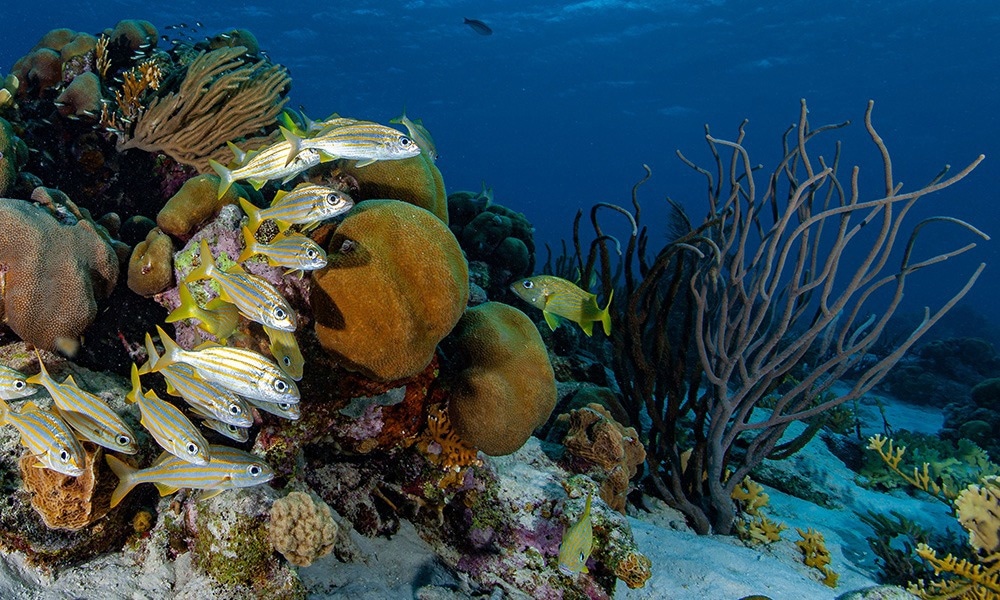A research team from UBC Okanagan has developed a computer modeling program to assist scientists in forecasting the impact of climate damage and potential restoration strategies on coral reefs all around the world.
 A UBCO researcher has created a modeling program that can help scientists plan for the restoration and conservation of coral reefs impacted by climate change. Image Credit: Jean-Philippe Maréchal.
A UBCO researcher has created a modeling program that can help scientists plan for the restoration and conservation of coral reefs impacted by climate change. Image Credit: Jean-Philippe Maréchal.
According to Dr. Bruno Carturan, this is a crucial goal because climate change is causing the extinction of numerous coral species and could trigger the collapse of entire coral reef ecosystems. However, due to their complexity, it is logistically difficult to investigate the effects of coral reef destruction and regeneration.
Real-world studies are impractical since they require manipulating sizable reefs, coral colonies, and herbivore populations, as well as monitoring long-term changes in structure and diversity.
Needless to say, conducting experiments that will disturb natural coral reefs is unethical and should be avoided, while using big aquariums is simply unfeasible. For these reasons, no such experiments have ever been conducted, which has hindered our capacity to predict coral diversity and the associated resilience of the reefs.
Dr. Bruno Carturan, University of British Columbia
Dr. Carturan recently completed his doctoral studies with the Irving K. Barber Faculty of Science.
Dr. Carturan employed models to generate 245 coral communities for his most recent study, which was published in Frontiers in Ecology and Evolution. Each of these communities contained a distinct collection of nine species and covered a surface area of 25 square meters. The coral colonies and various types of algae that grow, compete, and reproduce alongside one another while also being influenced by the climate are represented in the model.
Importantly, all of the model’s essential elements—including species’ features like competitive propensities and growth rates—are based on pre-existing, real data from 800 species.
The research team replicated numerous events, such as powerful waves, a cyclone, or extreme heat, and then assessed the resilience of each model reef by noting the amount of damage, how quickly it recovered, and the condition of the ecosystem ten years after the disturbance.
The scientists discovered that more varied communities—those with species having substantially disparate traits—were most resilient after testing a large number of scenarios using computer modeling. Ten years after the disruptions, they were more adept at repairing damage and had better habitat quality.
More diverse communities are more likely to have certain species that are very important for resilience. These species have particular traits—they are morphologically complex, competitive and with a good capacity to recover. When present in a community, these species maintained or even increased the quality of the habitat after the disturbance. Contrastingly, communities without these species were often dominated by harmful algae at the end.
Dr. Bruno Carturan, University of British Columbia
The strength and long-term health of coral reefs are determined by coral diversity, he continues. As their colonies create the physical habitat where countless fish and crustaceans thrive, coral species are the basis of coral reef ecosystems.
Among them are herbivores like parrotfish and surgeonfish that consume algae to preserve the coral ecosystem. Without herbivores, the algae would decimate a lot of coral colonies, bringing about the collapse of the coral habitat and wiping out its numerous populations.
What is unique with our study is that our results apply to most coral communities in the world. By measuring the effect of diversity on resilience in more than 245 different coral communities, the span of diversity likely overlaps the actual coral diversity found in most reefs.
Dr. Bruno Carturan, University of British Columbia
The research also demonstrates how the resilience of coral communities could be managed by establishing colonies of species with complementary features, which will aid in the restoration of coral reefs and give a framework for successfully managing these ecosystems.
There are further issues that the model can address in the future. For example, the most vulnerable coral species, which are crucial for resilience, are also the most impacted by climate change and may not be able to recover if extreme heatwaves occur too frequently.
Dr. Carturan states, “It is a very real, and sad conclusion that we might one day lose these important species. Our model could be used to experiment and perhaps determine if losing these species can be compensated by some other, more resistant ones, that would prevent the eventual collapse of the reefs.”
Journal Reference:
Carturan, B. S., et al. (2022) Functional Richness and Resilience in Coral Reef Communities. Frontiers in Ecology and Evolution. doi.org/10.3389/fevo.2022.780406.